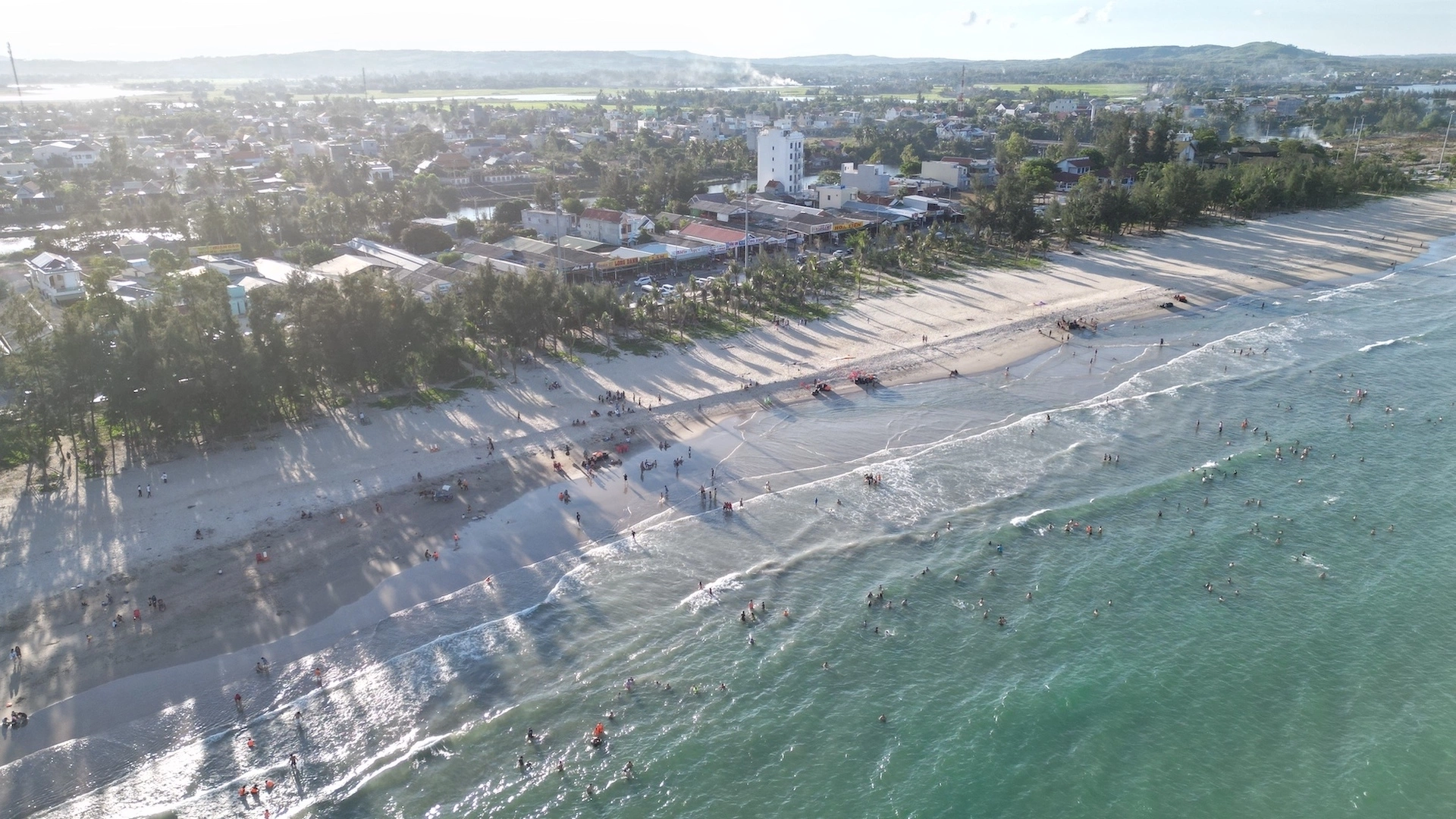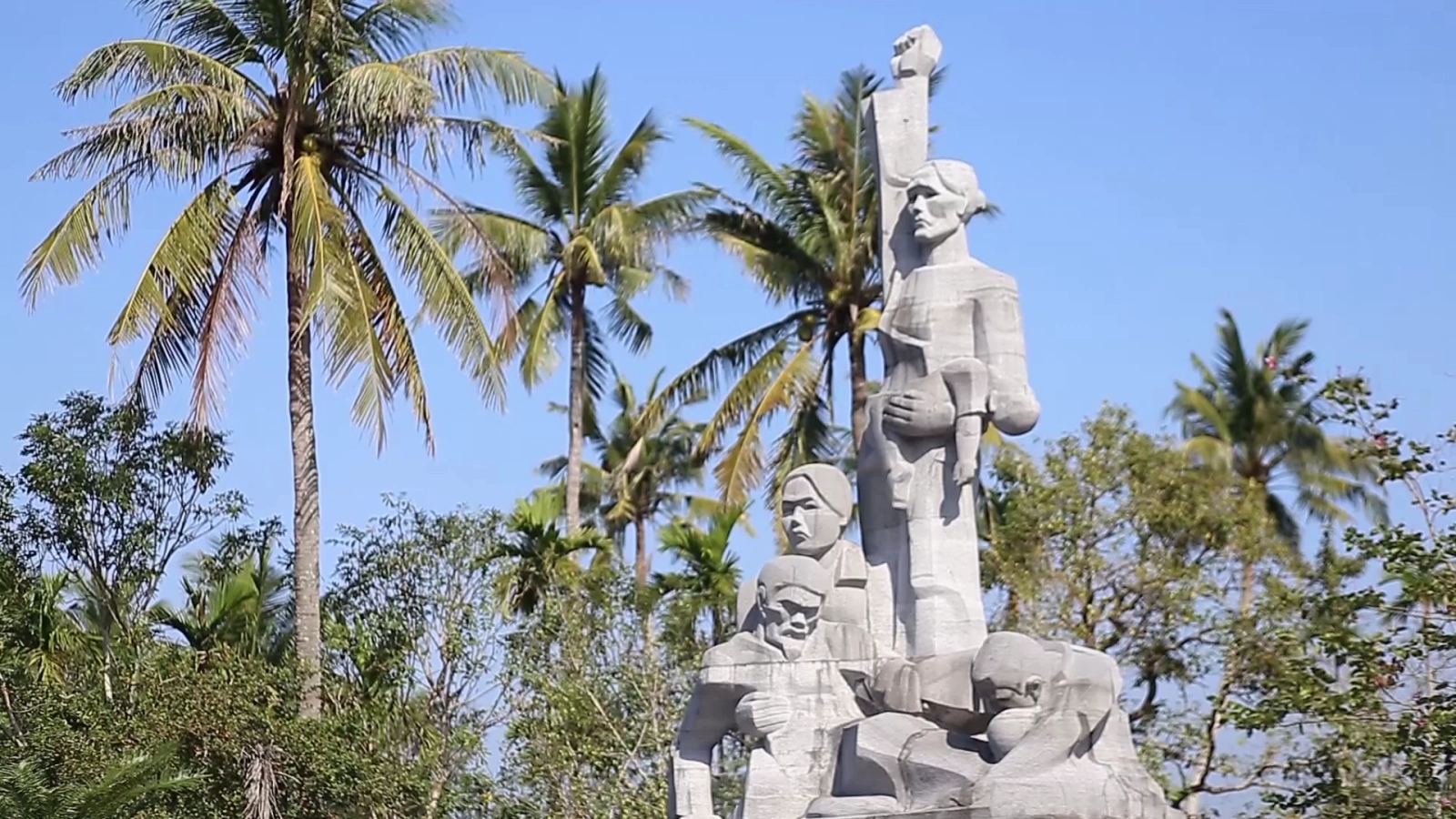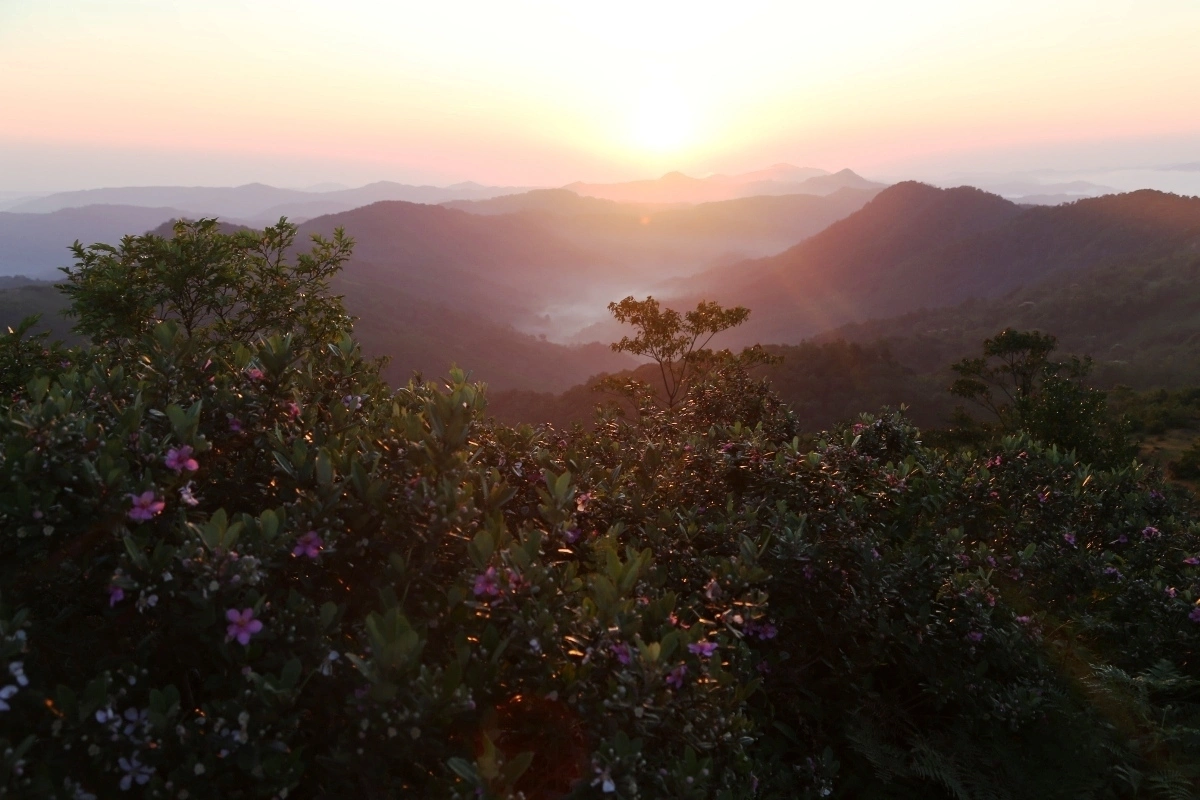
Quang Ngai Province, situated in the south-central coast of Vietnam, is 940 kilometers south of Hanoi, and 800 kilometers north of Ho Chi Minh City, along National Highway 1.
With a coastline spanning 130 kilometers, Quang Ngai features numerous picturesque spots and historical sites.
The best time for tourism in Quang Ngai is from April to August, characterized by dry, sunny weather without rain and storms, making it convenient for travel and recreational activities.

Co Luy Bridge, at the end of Tra Khuc River, Quang Ngai City, seen from the above. Photo by VnExpress/Pham Linh
Quang Ngai's tourist attractions are spread throughout the province, so visitors should carefully choose where to stay near attractions that align with their preferences, especially if they have limited time.
Quang Ngai City

From above, the Tra Khuc River reveals a heart-shaped sand dune adorning its banks. Photo by VnExpress/Pham Linh
Quang Ngai City, the capital of the province, spans is graced by the flow of Tra Khuc River at its center. Visitors can enjoy leisurely walks on both sides of the river, admiring the mudflats adorned with flowers and green melons at dawn and dusk. At the end of the Tra Khuc River is Co Luy Bridge, known as the most beautiful bridge in the province, offering views of sand dunes and the Cu Dai sea estuary bordering Quang Nam Province. While the inner city of Quang Ngai has fewer tourist spots, it serves as a gateway to explore attractions such as Thien An Mountain, the Son My Ruins, Tinh Khe Nipa Forest, and My Khe Beach.
Ly Son Island
Ly Son District, located 15 nautical miles from the mainland, spans an area of 10.39 kilometers square and is home to over 22,000 people. Ly Son was recognized by Forbes Magazine in 2019 as one of the 10 most beautiful beaches in Vietnam. It is also referred to as the "garlic kingdom" thanks to its agricultural traditions.
The island boasts two craters, Gieng Tien and Thoi Loi, as well as over 50 historical and cultural relics and two archaeological sites. It is a treasure trove of tangible and intangible cultural values, encompassing elements from three ancient cultures: Sa Huynh culture, Champa culture, and ancient Vietnamese culture.
Ly Son is rich with traditional festivals, most notably the Feast and Commemoration Festival for Hoang Sa Islands' Soldiers and a boat racing festival, both of which are listed as national intangible cultural heritages.
The island also holds historical documents and evidence that establish Vietnam’s sovereignty over the two archipelagos of Hoang Sa (Paracel) and Truong Sa (Spratly).
My Khe Beach

My Khe Beach is about 15 kilometers from the center of Quang Ngai. It is one of the province’s most famous and beautiful beaches. A taxi ride from the city center to My Khe costs around VND200,000 ($8.45). Visitors can also opt for bus route 03 to arrive at the destination. The beach is about 10 kilometers away from Sa Ky Port, making it an ideal place to stay before embarking on a journey to Ly Son Island.
For accommodation options, My Khe offers establishments such as My Khe Hotel, Chau Ngoc Vien Hotel, as well as homestays like Nha Minh and Lang Bien.
Tu Nghia coconut area
Located approximately 10 kilometers from the city center, the Tu Nghia coconut area features about 200 coconut trees. Visitors can revel in the lush green surroundings and savor the freshness of coconut drinks. Tu Nghia also features floating eateries serving local dishes. This destination not only attracts tourists but also serves as a protective barrier for villagers during storms.
Son My Memorial

Son My Memorial, in Son Tinh District, 13 kilometers northeast of Quang Ngai City, is a site that bears witness to the atrocities committed by the American soldiers during the Vietnam War. On March 16, 1968, the U.S. army conducted an operation that led to the loss of 504 Vietnamese people, including 182 women, 173 children, 60 elderly individuals, and 24 families. Additionally, 247 houses were burned. The Son My massacre is considered a dark chapter in American crimes against the Vietnamese people during the Vietnam War.
Son My Memorial covers an area of 2.4 hectares, adjacent to provincial road 24B. It features both original preserved relics and later additions, including additional galleries, reception areas, monuments, and garden statues. Steles are placed outside the evidence grounds to mark the spot where the shooting occurred.
The site is open to visitors every day from 7 a.m. to 5 p.m., and the ticket price is VND20,000 (84 cents).
Bui Hui Steppe

During sunrise, the steppe comes alive with the beauty of purple myrtle hills. Photo by VnExpress/Thanh Su
Bui Hui Steppe, in Ba Trang Commune, Ba To District, known as the buffalo capital of Quang Ngai, lies more than 70 kilometers west of Quang Ngai City. Covering tens of hectares, the steppe features a myrtle hill with purple hue. The myrtle season occurs around June and July, when locals wear traditional costumes to the hill for myrtle picking. Visitors can enjoy the beauty of flowers and myrtle fruits, and purchase myrtle wine from the local H’re people.
The steppe offers cloudy and foggy sunrise and sunset, creating an ethereal experience that makes visitors feel like they can reach out and touch the horizon. It is an ideal place for picnics and camping with friends and family, offering a peaceful retreat after busy days in the city.
Ba Lang An Peninsula

Ba Lang An Peninsula, in Binh Chau Commune, Binh Son District, offers a serene spot to unwind and experience the beauty of the sea and islands. The peninsula is formed by volcanic sedimentary cliffs, accompanied by the presence of a crystal-clear blue sea. The name "Ba Lang An" originates from the presence of three villages with the same "An" (peace) in their names: An Hai, An Vinh, and An Ky. Discovered by the French, this place marks the easternmost point of Quang Ngai Province and serves as the closest location to Ly Son Island. It boasts abundant seafood resources and is also known on the world map as Batangan.
At Ba Lang An Peninsula, visitors can relish a panoramic view of the peninsula from the 36-meter-high lighthouse, stroll along the coastline, and capture moments with the layers of rocks or the dormant crater.
Sa Huynh salt field
The Sa Huynh salt fields, located along National Highway 1A in Duc Pho District, about 60 kilometers south of the city center, is one of the most renowned salt fields in the central region. It covers an area of 110 hectares. Visitors can take guided tours of the salt field and learn the history of the local salt industry. They can explain how salt farmers utilize the sun and wind to produce salt and highlight the architecture of the salt fields, including the irrigation ditches.
Visitors can even try raking salt themselves or learn about the microbiology of salt fields. The salt fields offer a perfect setting for photography, particularly at sunset when the fields reflect the warm sunlight.
Minh Long Waterfall
The Minh Long White Waterfall is about 30 kilometers from the Quang Ngai city center. Nestled in the forested mountains, the waterfall has a height of over 40 meters, making it one of the most stunning waterfalls in the province. At the base of the waterfall lies a natural lake, allowing visitors to enjoy a swim. Then the 20-meter-wide stream winds through a valley before merging with other streams.
Thien An Mountain
Thien An Mountain, regarded as a symbol of Quang Ngai, stands proudly with its scenery, and has a height of about 135 meters. This esteemed location has been designated a national monument and landscape.
When visiting Thien An Mountain, make sure to visit Thien An Pagoda, which has been recognized as a national historical and cultural relic since 1990. The pagoda is surrounded by a landscape of untamed mountains and lush forests, creating a refreshing atmosphere. The route leading to the pagoda may have some winding stretches, so visitors should exercise caution while moving around.
Ganh Yen
Ganh Yen is situated in the fishing village of Thanh Thuy, Binh Hai Commune, Binh Son District, 35 kilometers north of Quang Ngai City. The area offers sedimentary rock formations stacked in intriguing shapes. During low tide, you can marvel at the vibrant colors of coral reefs. Ganh Yen has not only geological features along the shore but also a diverse marine ecosystem.
Visitors can dive and witness the abundance of coral flowers on the seabed or join locals in fishing for crabs and squid using traditional methods. Seaside eateries offer fresh and affordable seafood dishes, adding to the charm of the place.
Bau Ca Cai
Bau Ca Cai is situated in Tuyet Diem Village, Binh Thuan Commune, Binh Son District, 50 kilometers north of Quang Ngai City. The mangrove forest and lagoon cover an area of 83 hectares, with 50 hectares dedicated to lumnitzera littorea trees and six-year-old mangroves under management and protection, while the remaining area is undergoing new planting.
These trees were planted as part of a five-year project to improve climate change resilience of Vietnam's vulnerable coastal communities (2017-2022). Following a successful planting, the area was entrusted to local communities for preservation and the development of tourism. During autumn, the beauty of the coc trang trees captivates visitors, especially photographers.
Don
Don is a specialty of Quang Ngai, found in the Tra Khuc and Ve rivers. This creature belongs to the mussel family and is typically found in brackish water areas.
During the dry season around April and May, locals venture to search for don, which dwells buried in the sand, making the process quite laborious.
To cook don, it undergoes a washing process before being placed into boiling water. It is then stirred vigorously to encourage the opening of its mouth, resulting in the release of flavors into the boiled water. The clear water is then separated and seasoned to taste. Don is then cleaned thoroughly again. When ordered, vendors scoop some don into a bowl and add rice paper, onions, scallions, and cilantro before filling it with broth.
To enhance the taste, don is served with chili, garlic, and pepper. It can be enjoyed at any time of the day, but Quang Ngai residents often indulge in it during the late afternoon. Some popular places to find don include Don Co Luy at 115 Chu Van An Street, Don Gao Dua on Truong Sa Street, and Don Thanh Nhan on Quang Trung Street.
Sillago fish from Tra Khuc River
Sillago fish from Tra Khuc River is a delicacy among the people of Quang Ngai, often featured in their daily meals and considered an essential dish in their lives. The best time to enjoy the fish is during the summer. Fishermen use bamboo tubes, which are about 1 meter long, to catch the fish. Each tube has two ends, and the sharp stake end is inserted into the water.
Once caught, the fish is placed in an earthen pot and seasoned with chili, onions, and pepper. It is cooked over a fire with onions, chili, garlic, and a dash of pepper and water for over an hour. The resulting fish is firm, fragrant, and savory, making it a perfect accompaniment to white rice.
Together with don, sillago fish from Tra Khuc River has earned a spot in the top 50 most delicious dishes in Vietnam, as recognized by the Vietnam Record Book Center.
Banh xeo (crispy pancakes)
Unlike southern crispy pancakes, banh xeo in Quang Ngai are crafted in a smaller mold, measuring about 20 centimeters in diameter. The crust is crafted from fresh rice flour, yielding a soft pancake filled with shrimp, pork, and bean sprouts. As per the locals' wisdom, the longer the mold is seasoned, the better the pancakes turn out, preventing sticking and burning.
To savor banh xeo to the fullest, it is enjoyed with sliced unripe bananas, cucumbers, herbs, lettuce, and heartleaf, complemented by a dipping sauce consisting of fish sauce mixed with chili and Ly Son garlic. Some popular places to try this delightful dish include 124 Phan Dinh Phung Street, 471 Le Loi Street, Mrs. Loi shop at My Khe Beach, and Mrs. Dung shop at Tinh Khe Commune.
Ram bap (corn spring rolls)
Corn spring rolls are a dish crafted from either kernels of waxy corn or kernels of yellow corn. The kernels are mixed with a blend of salt, pepper, onions, and shallots, before being wrapped in thin and chewy rice paper.
Once rolled, the corn spring rolls are fried in hot oil, creating a golden and crispy texture. This dish is best enjoyed when hot, accompanied by a side of sweet and sour fish sauce and fresh herbs.
Corn spring rolls are not only a common item in family meals and local snack shops but also hold a special place for the people of Quang Ngai as an essential vegetarian dish during the commemoration of death anniversaries and on full moon days.
Seafood
Like many coastal regions in Vietnam, Quang Ngai offers a wide variety of fresh seafood that is caught and consumed on the same day. Noteworthy dishes include crabs, sea urchins, and oysters. Seafood in Quang Ngai is reasonably priced, with a satisfying meal costing less than VND300,000 ($12.67) per person. For an enjoyable seafood experience, some recommended places include restaurants along My Khe Beach and the Tra Khuc embankment, or eateries such Tuan Map on Tran Phu Street, Phuong Oc on Truong Quang Giao Street, and Vu Cua on Phan Dinh Phung Street.
Mirror candy
Mirror candy is a treat with a clear, light yellow color from peanuts and a white-yellow hue from sesame seeds. It was brought to Nghia Hoa Commune, Tu Nghia District, by Chinese settlers from Chaozhou, Guangdong, and has been passed down through generations. The crispy candy has a sweet and nutty flavor, making it an ideal match with lotus tea.
Quang Ngai does not have its own airport, so travelers can travel to Chu Lai Airport in Quang Nam, which is about 40 kilometers away from Quang Ngai city. From Chu Lai, there are several travel options:
1. Taxi: Mai Linh and Sun are popular airport taxis, charging between VND450,000 to VND600,000 ($18.99 to $25.32) for one-way travel.
2. Airport bus: The bus journey from Chu Lai airport to the center of Quang Ngai City takes approximately 1 hour and 30 minutes and is suitable for individual or small group travelers with minimal luggage. The ticket price is VND60,000.
3. Car service: Shuttle services are offered at around VND450,000 for 4-seater cars and between VND850,000 to VND1 million for 12 to 16-seater cars. Alternatively, visitors have the option to rent self-driving cars, which cost approximately VND700,000 to VND1 million per day, depending on the car's type.
Travelers arriving from Hanoi or Ho Chi Minh City can also take the Thong Nhat train, which stops at Quang Ngai station. The round-trip ticket price for the fastest train varies from VND1.4 million to VND2 million from Hanoi and VND1 million to VND1.5 million from Ho Chi Minh City.
Within Quang Ngai City, motorbikes are the most convenient transportation option. Visitors can easily rent a motorbike from their hotel for around VND100,000 per day, depending on the type of motorbike.
Quang Ngai does not offer many luxury hotels or resorts. The lodging options are divided by area, catering to the preferences and needs of different visitors and tourists.
In Quang Ngai City, on the south bank of Tra Khuc River, some of the available hotels include the historic Song Tra Hotel, Thien An Riverside Hotel, and Luxury Hotel. Nearby areas provide options like King Hotel, Central Hotel, and Cam Thanh Hotel. Room rates in these establishments typically range from VND400,000 to VND700,000 ($17 to $30) per night. In the inner city, there are budget-friendly motels and homestays, such as Turi and Tron, with rates around VND200,000 per night.
Following the expansion of Quang Ngai City in 2014, parts of Son Tinh District in the northeast and Tu Nghia District in the southeast were merged to facilitate development on both sides of the river, facing the sea. In the southern suburbs along the Tra Khuc River, visitors can find accommodations like Cocoland River Beach Resort & Spa in Bai Dua tourist area in Tu Nghia District. In the north, there are homestays and hotels like My Khe Hotel on My Khe beach.
In the northern regions of Binh Son District, visitors have the option to stay at hotels and homestays in Chau O Town by the Tra Bong River. These accommodations are convenient for exploring local attractions in the area. In the southern part, Sa Huynh area offers Sa Huynh Resort with prices ranging from VND500,000 to VND1.2 million ($21.11 to $50.66) per night.
Story by Pham Linh, Tam Anh